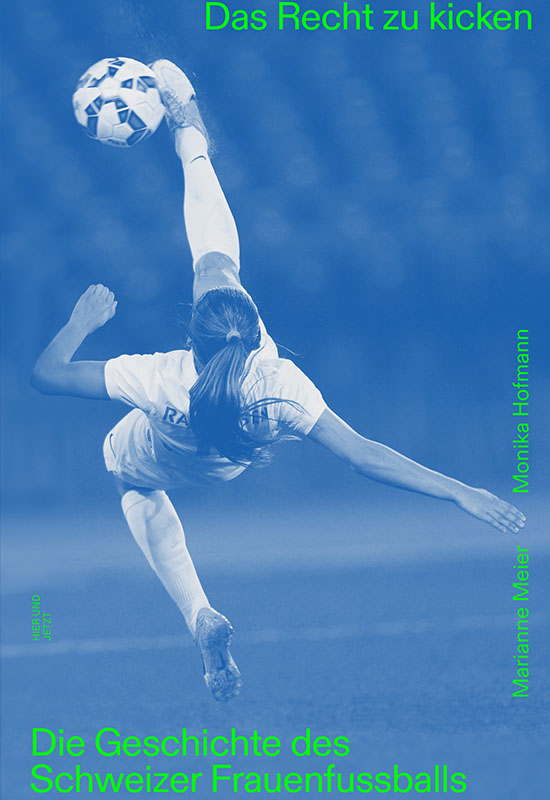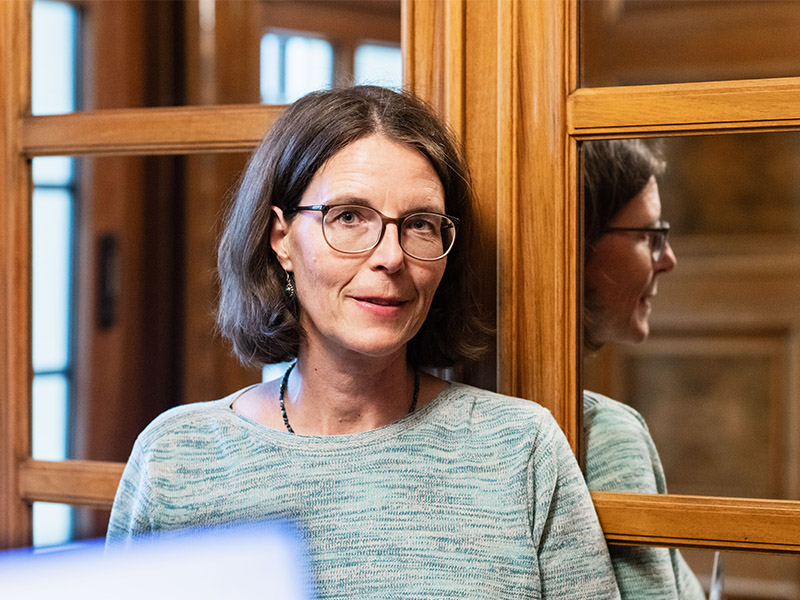Tackling the clichés
Women’s soccer breaks down gender norms
Just in time for the Euro 2025 soccer tournament, two Bern-based researchers are publishing a new book, “Das Recht zu kicken” [The Right to Kick]. During an interview, co-author Marianne Meier recounts historical anecdotes and pits Swiss women’s soccer against gender stereotypes.

Marianne Meier: I’m thrilled with how much women’s soccer has grown, how much more visible it is now. Just look at the advertising for these Euros: There are trams and buses decorated in the tournament colors, so many interesting fringe events – and so many sold-out games! However, it does bother me that so many people who’ve previously stood in the way of women’s soccer are now suddenly basking in the glory of this tournament. This is a moment when we should be celebrating the people who have worked so hard to ensure we can experience this momentum.
In your new book, “Das Recht zu kicken”, you give those pioneers a voice. What were you aiming to achieve by doing that?There were a lot of reasons, but most of all we wanted to show that the current boom in women’s soccer didn’t just come out of nowhere. We wanted to thank the countless women who’ve fought for the right to play soccer over the last 100 years – as officials, referees, coaches and players. We wanted to give those pioneers a voice and make them visible. There are also plenty of men who’ve fought for the cause: fathers of girls who’ve played, and even one former coach of the Nati [the Swiss national team], who organized and funded a training camp in his hometown for the players in 1989.

The first confirmed source I found dated back to 1923. It was a newspaper ad posted by a group of women in Geneva who were looking for similarly minded people to play soccer with. It was all very informal, a characteristic that shaped the first phase of such pioneers for decades.
There were lots of talented women soccer players in Switzerland in the Sixties, but they were banned from playing official matches because of their gender. So they moved to Italy – or became referees instead. Women were allowed to referee men’s games because the federation couldn’t find enough men for the job. Women’s soccer became established in 1970 with the foundation of the Swiss Damenfußballliga, or SDFL. A national league championship and national team were set up. However, this disappeared from the public eye between 1976 and almost the millennium, due to a lack of success and media interest.
“In 1972, the national team were sent Swiss Crosses by express mail, and had to sew these onto their jerseys themselves.”
Marianne Meier
In 1993, women’s soccer came in from the cold and was integrated into the Swiss Football Federation, the SFV. A structured youth development program was launched for women and girls, eventually culminating in the opening of a national talent center in Huttwil in 2004. Huttwil’s first year included such talents as Ramona Bachmann, who has now been a national team leader for many years.
Such support measures brought success, as demonstrated by the fact that the Swiss Women have now qualified for every World Cup and Euros finals since 2015. In 2020, the league obtained its first sponsor, and league games were broadcast live on TV for the first time. Since then, the visibility of female soccer players has gone from strength to strength.
Subscribe to the uniAKTUELL newsletter

Discover stories about the research at the University of Bern and the people behind it.
The early years up to 1970, without doubt. Women were banned from playing official, organized soccer matches because of their gender. But there have been plenty of other episodes over the years, some worse than others. For the national team’s first game in 1972, for example, the players were sent jerseys with no numbers on them, because the Federation claimed they didn’t know what sizes the players wore. What’s more, the Swiss Crosses were sent by express mail after the team had left, so they had to sew them onto the jerseys themselves.
What’s remarkable is that the women never complained about this kind of thing. They just wanted to play soccer, and they wouldn’t let anyone stop them. That tenacity and passion are what set these trailblazers apart.
Another example is DFC Therwil in the 1970s. There, the women’s team played on a tar pitch or another field next to the men’s pitch – which was also used as a dog toilet. The players had to clean the whole area before they could train. But these issues also extend into more recent times. When former elite player, Lara Dickenmann, became coach of Grasshopper Zürich’s women’s team in 2021, they didn’t give her an office. In an interview for the book, she described the workspace they assigned her as “a broom cupboard with a shower – [my] coat and bag went straight on the floor.” And she fought hard just to get that!

Nicole Petignat, a former FIFA referee who officiated in the top men’s leagues, told us, “‘Pute’, c’était comme ‘bonjour’” – she’d hear the word “whore” just as often as people said “hello” to her. Nevertheless, she persisted, never letting the abuse get to her – even when it came from the media. She told us that every insult just spurred her on more.
It’s as if soccer acts as a magnifying glass, holding up a mirror to our society’s treatment of women as a whole.You could say that, yes. Soccer is one of the last bastions of masculinity. I think that’s got a lot to do with the competitive nature of the game. You got to be aggressive, seek out physical contact, wear your muddy shorts and bloody nose as badges of honor. These aren’t seen as things women are supposed to do. We’re meant to be the opposite: soft, sweet, pretty.
“With every dribble, every first touch, every header, female soccer players rebut the prejudices faced by women.”
Marianne Meier
Soccer’s position as the most popular sport in the world has made the recent growth in the women’s gave even more symbolic. Players are becoming ambassadors for Cailler, Pepsi and other world-famous brands, making for a hugely diverse set of role models. These are lesbian, heterosexual and bisexual women, who have long or short hair, birth children and keep on playing.
This broadens the spectrum of what it means to be a woman, breaking down rigid gender norms and deconstructing clichés. The same applies to stereotypes in sport, where even children use “you kick like a girl” as an insult. With every dribble, every first touch, every header, female soccer players rebut these prejudices.
You also criticize the one-sided gender marking often found in football: People are calling the upcoming tournament the “Women’s Euro”, or “WEURO” - but you never hear them say “the men’s Euros”. What do you think is the solution to this?I’d propose using gender markers for everyone. I call our national teams the “men’s Nati” and “women’s Nati”, and the tournaments are the “men’s Euros” and “women’s Euros”. It’s the same model as in skiing, where everyone uses the terms “women’s downhill” and “men’s downhill”. No-one would say, “the women’s downhill on Saturday is followed by the ‘downhill’ on Sunday.” Everyone would wonder who the second one was for. But this kind of terminology is normal in soccer. It’s a habit that cements men’s soccer as the measure of all things and defines women’s soccer as a second-rate copy. Language shapes our reality.
Do you think women’s soccer in Switzerland can continue to write history after this year’s Euros?That depends on how serious the SFV and the sponsors actually are when they say they want to continue professionalizing the Swiss Women’s Super League. Among other things, that would mean giving every professional player the security of a contract and a livable wage.
The SFV has established “Here to stay” as its motto for the legacy of these Euros. As part of this legacy project, the Federation wants to double the number of female players, referees, coaches and officials in the game by 2027. It sounds great – but it’s not really feasible. According to official numbers, we currently have over 40,000 girls and women playing soccer in Switzerland. If that doubled to 80,000, we wouldn’t have enough changing rooms or pitches to go round. It might have been better to aim for a goal with a greater leverage effect, like increasing the number of female referees in both women’s and men’s soccer tenfold, from 2.6 to 26 percent. After all, women referees are visible role models. And as history shows, role models are essential.
Information about the publication
“Das Recht zu kicken” was published in German on June 9 by “Hier und Jetzt”, and is due out in French on June 26. Co-author Monika Hofmann also hosts an accompanying podcast, “Fussballpionierinnen – Pionnières du foot” (available on all common podcast platforms).
Das Recht zu kicken
Die Geschichte des Schweizer Frauenfussballs
Marianne Meier und Monika HofmannMarianne Meier und Monika Hofmann
approx. 304 pages, approx. 70 images in color and b/w, Fr. 39.00
German print 978-3-03919-638-8; German ebook 978-3-03919-687-6
Droit au but
L'histoire du football féminin suisse
Marianne Meier et Monika Hofmannapprox. 304 pages, approx. 70 photos, Fr. 39.00
French print 978-3-03919-639-5; French ebook 978-3-03919-686-9
About Marianne Meier

Dr. Marianne Meier
is a historian, senior researcher and lecturer at the University of Bern’s Interdisciplinary Centre for Gender Studies.
About Monika Hofmann

Monika Hofmann
is a project manager in the fields of teaching, research and knowledge communication at the University of Bern’s Interdisciplinary Centre for Gender Studies.